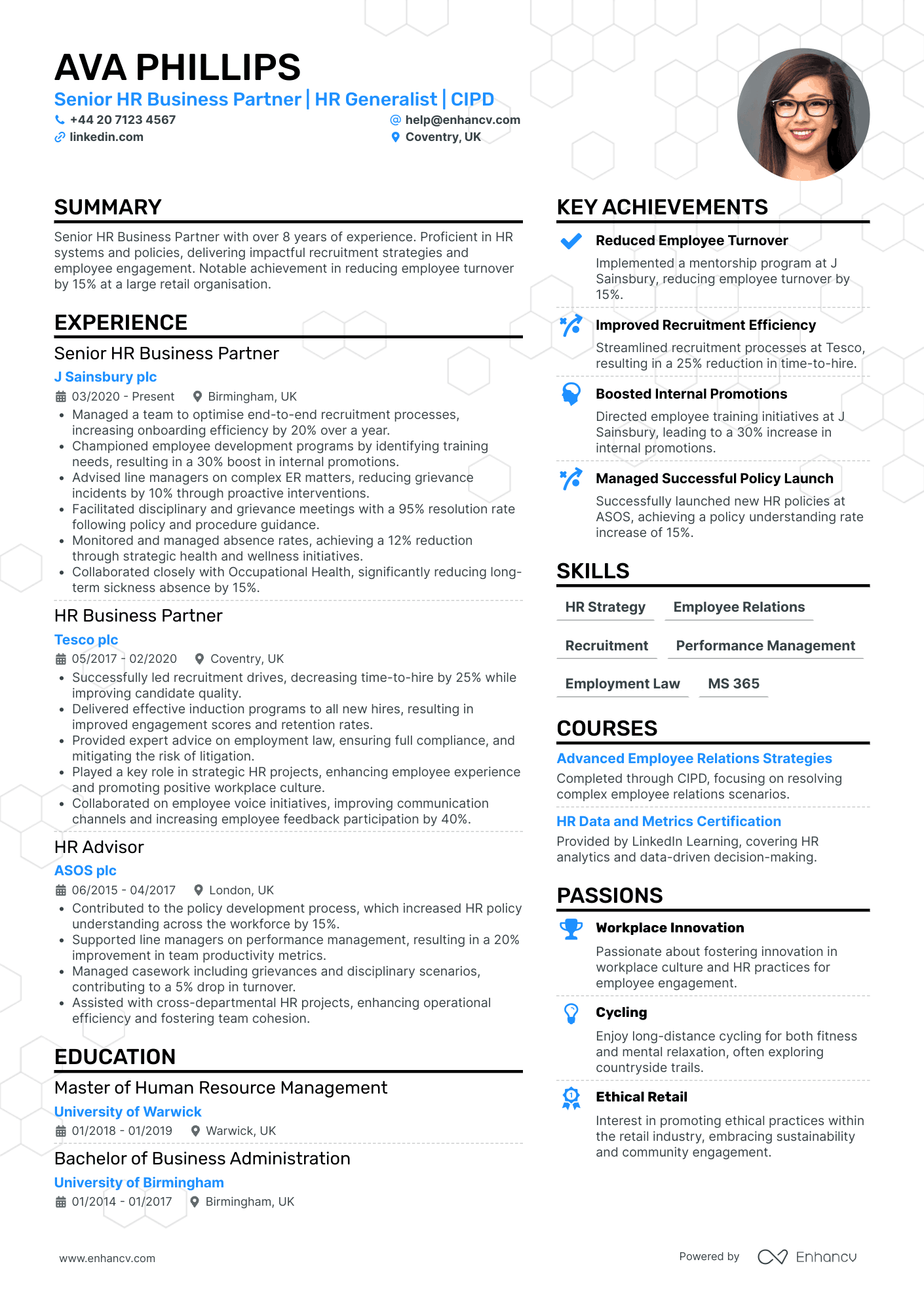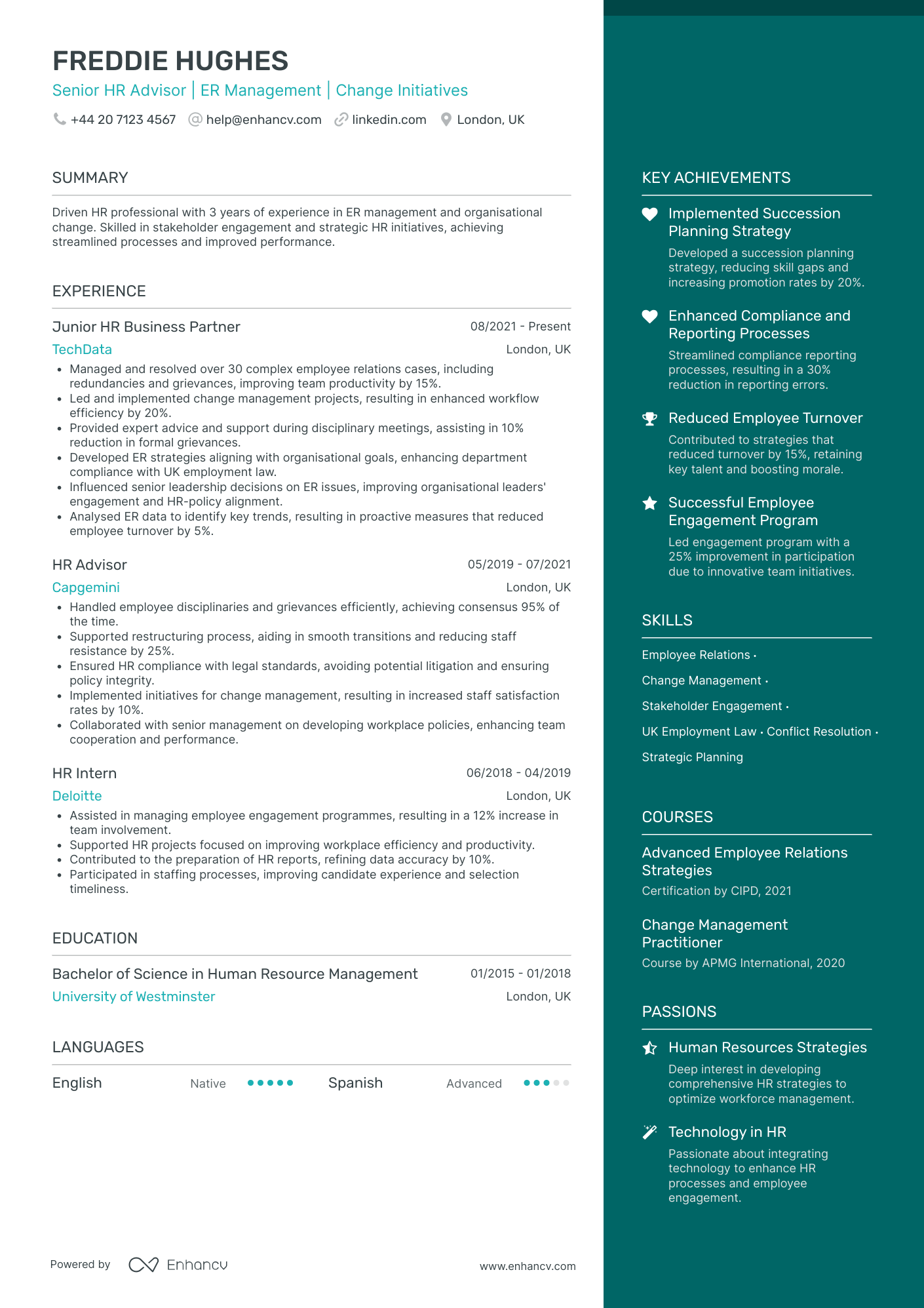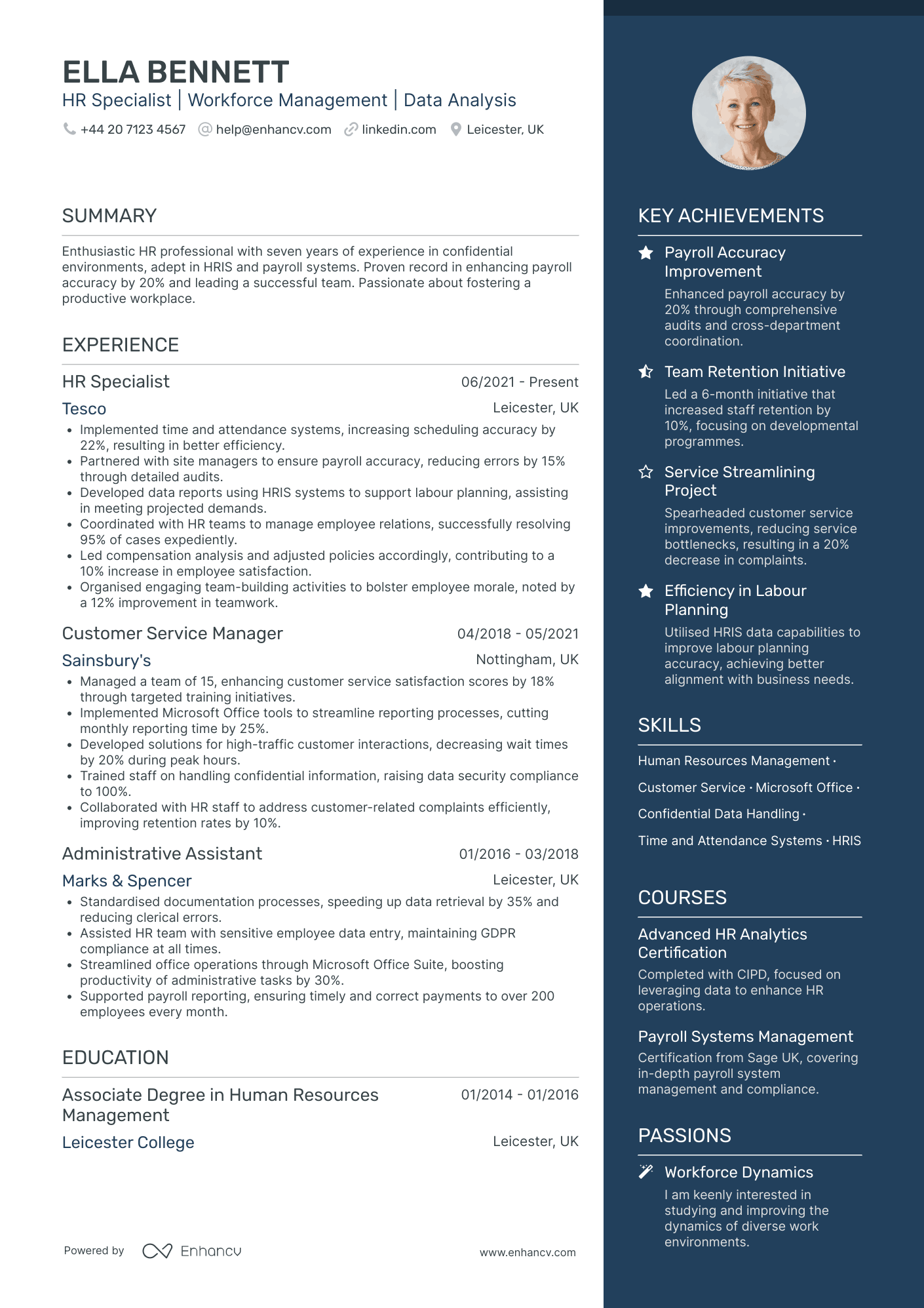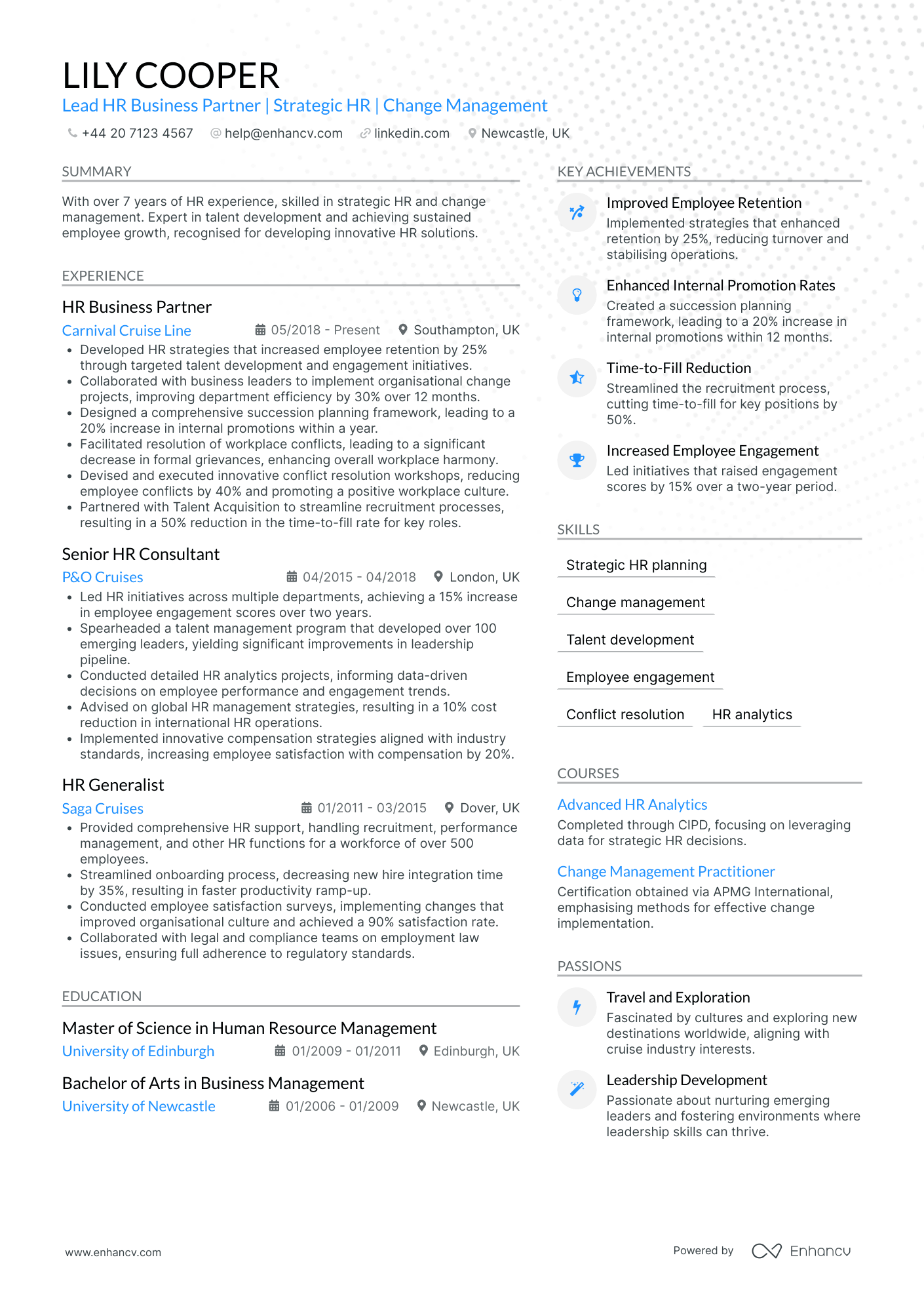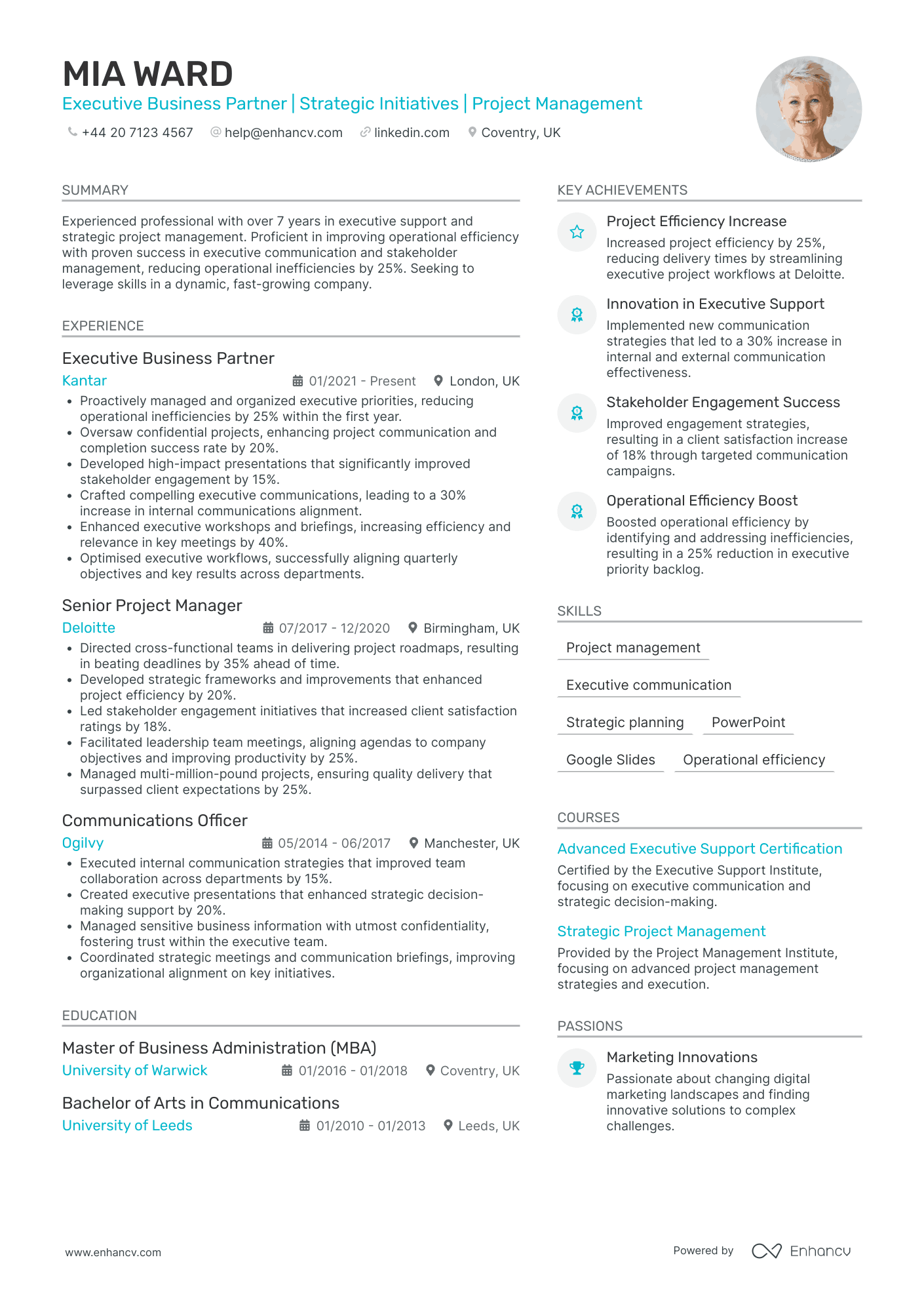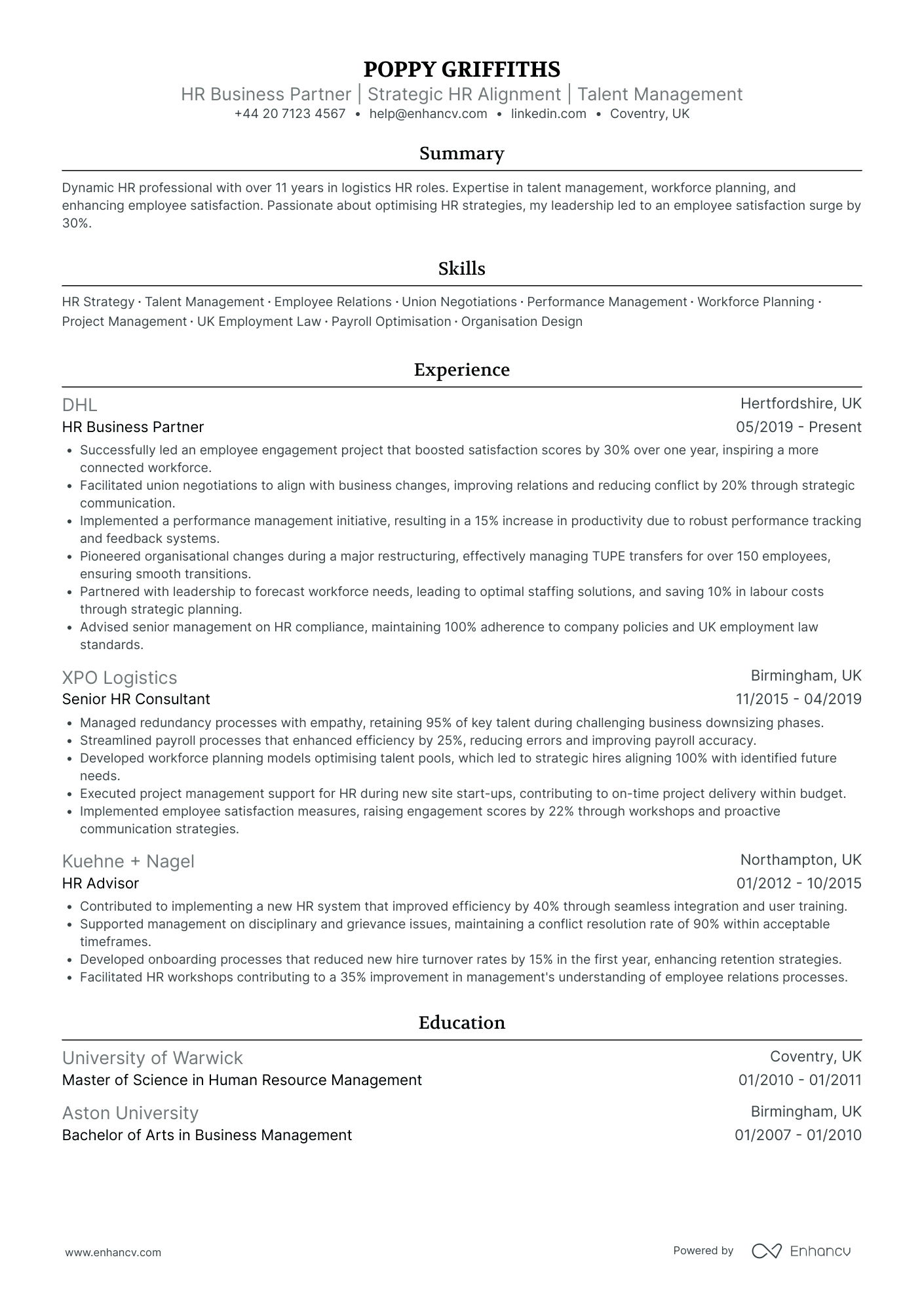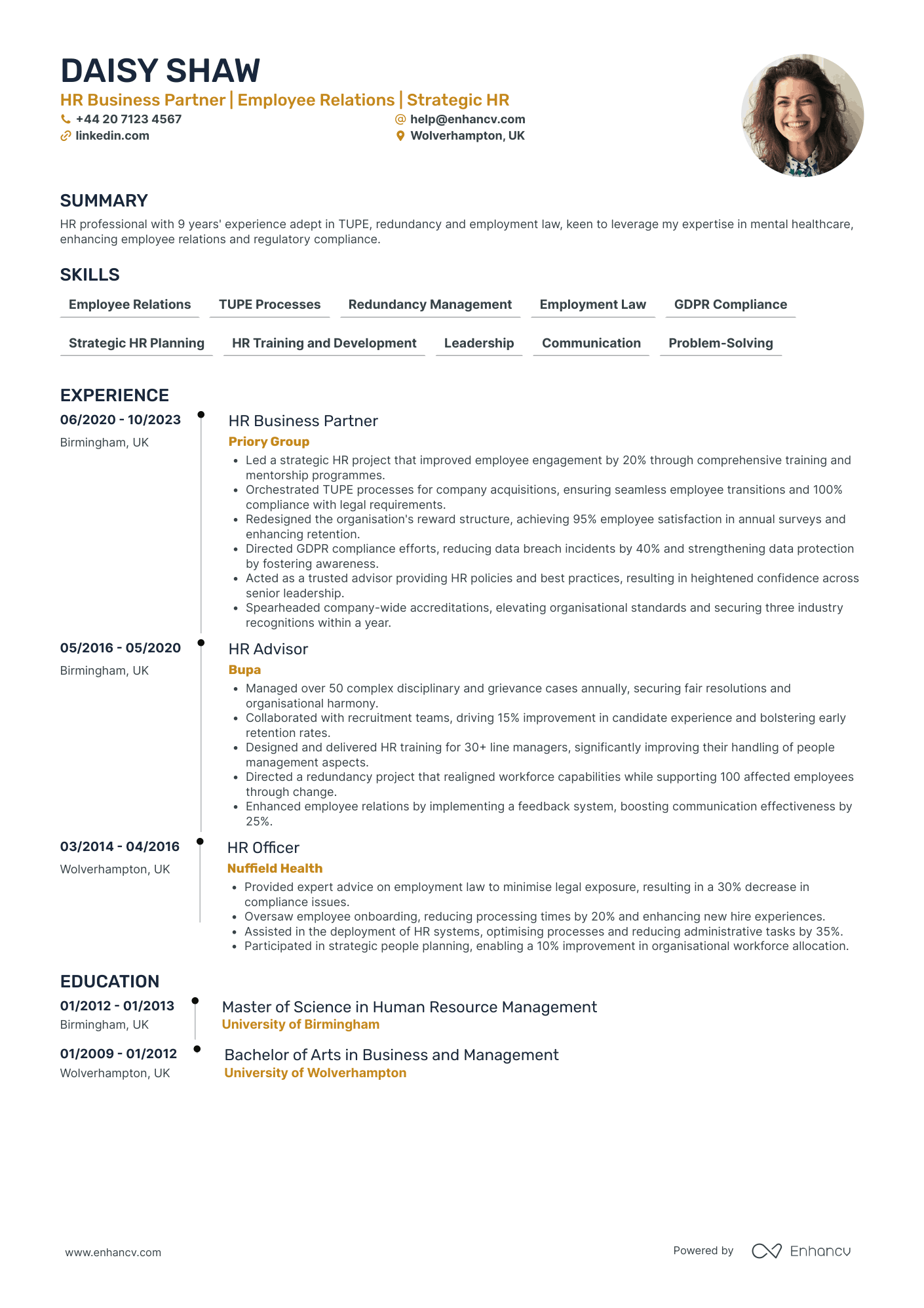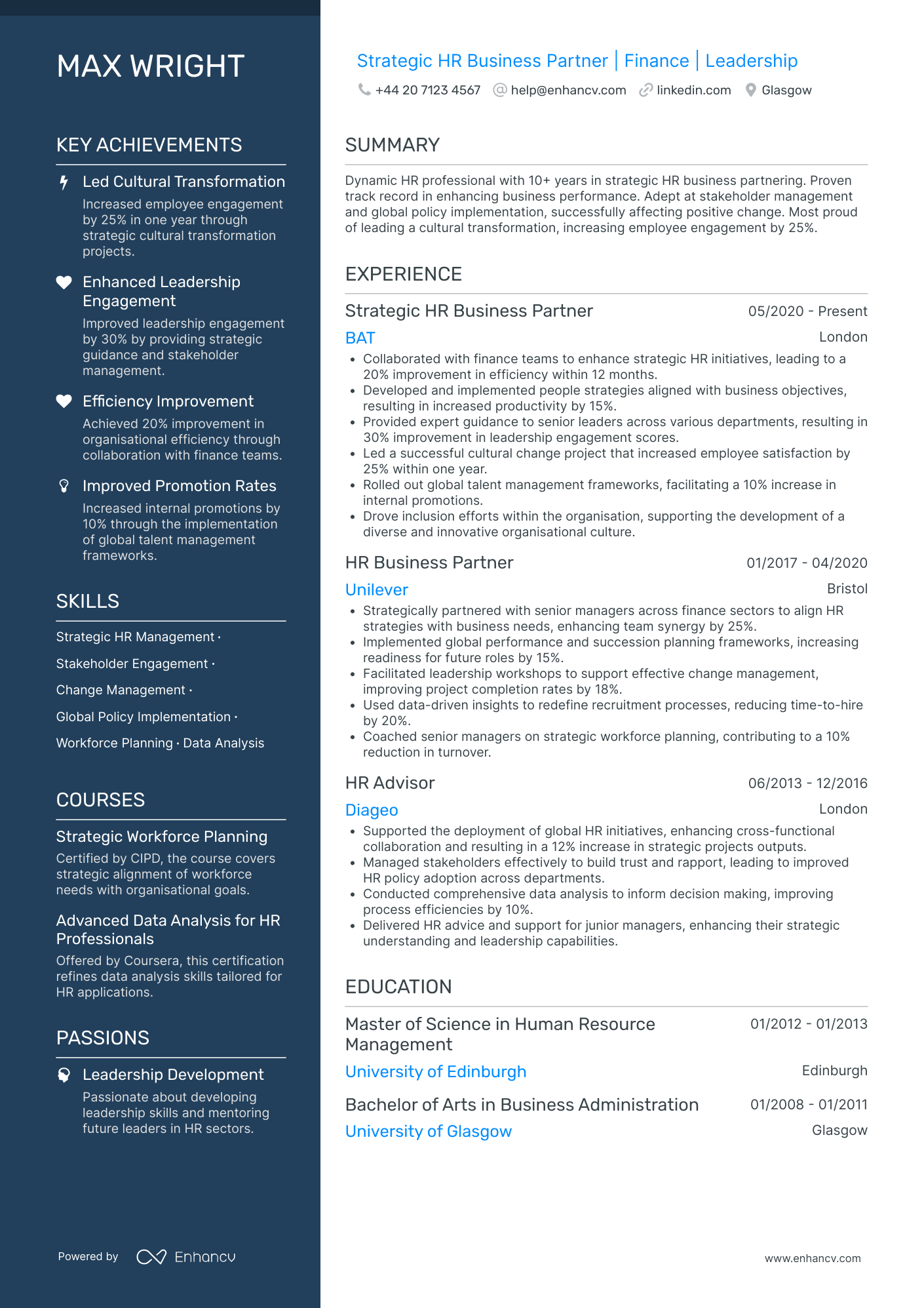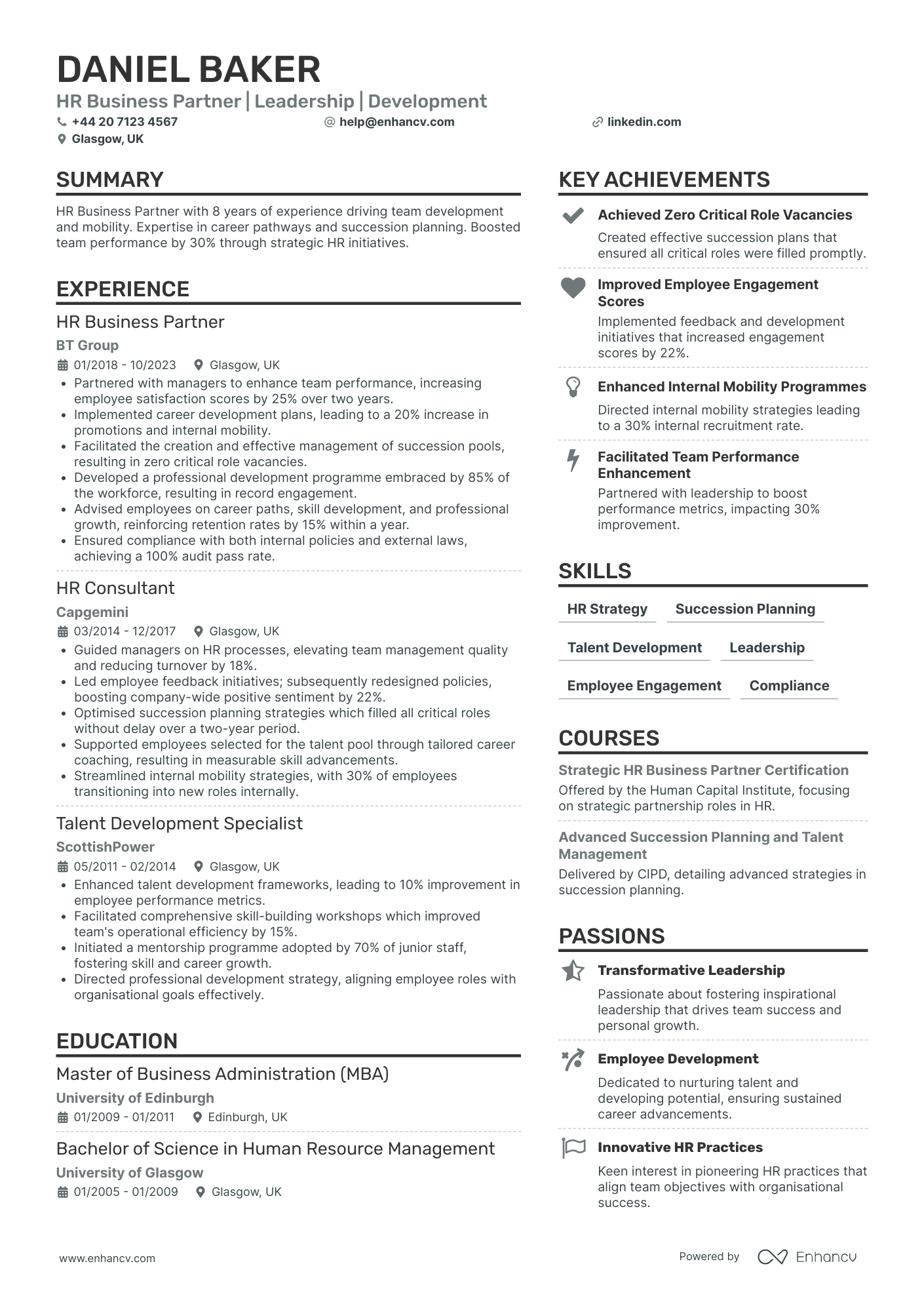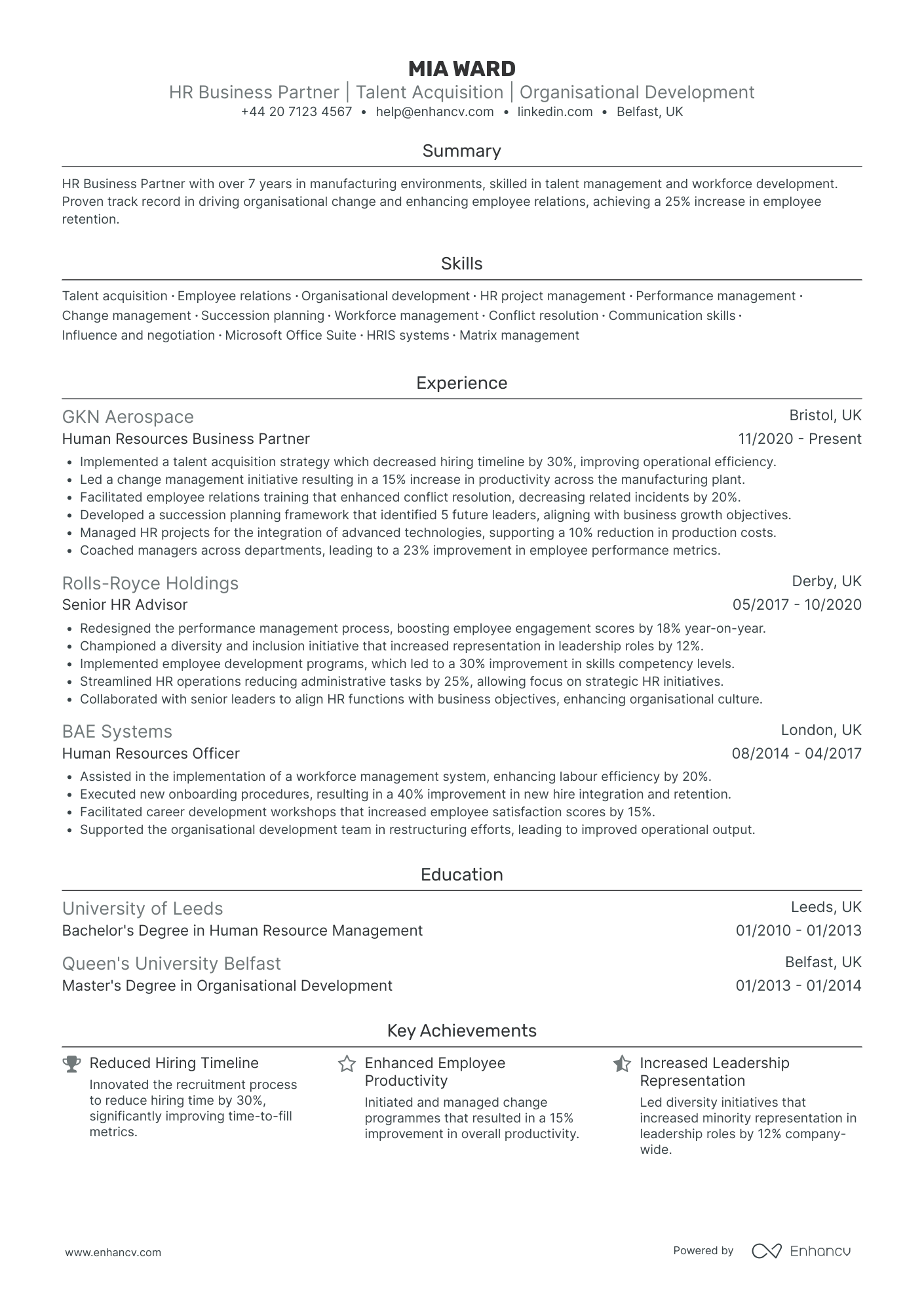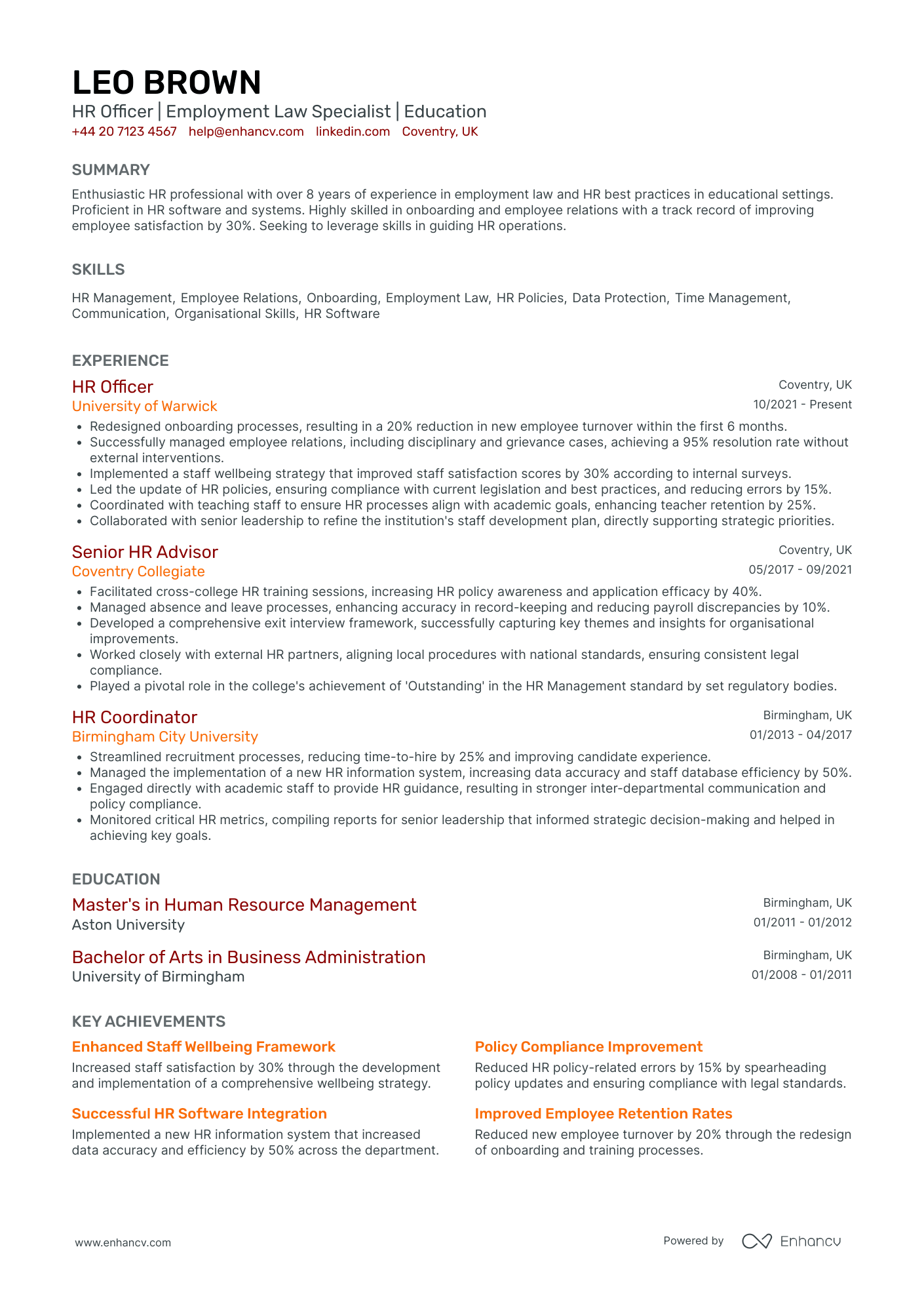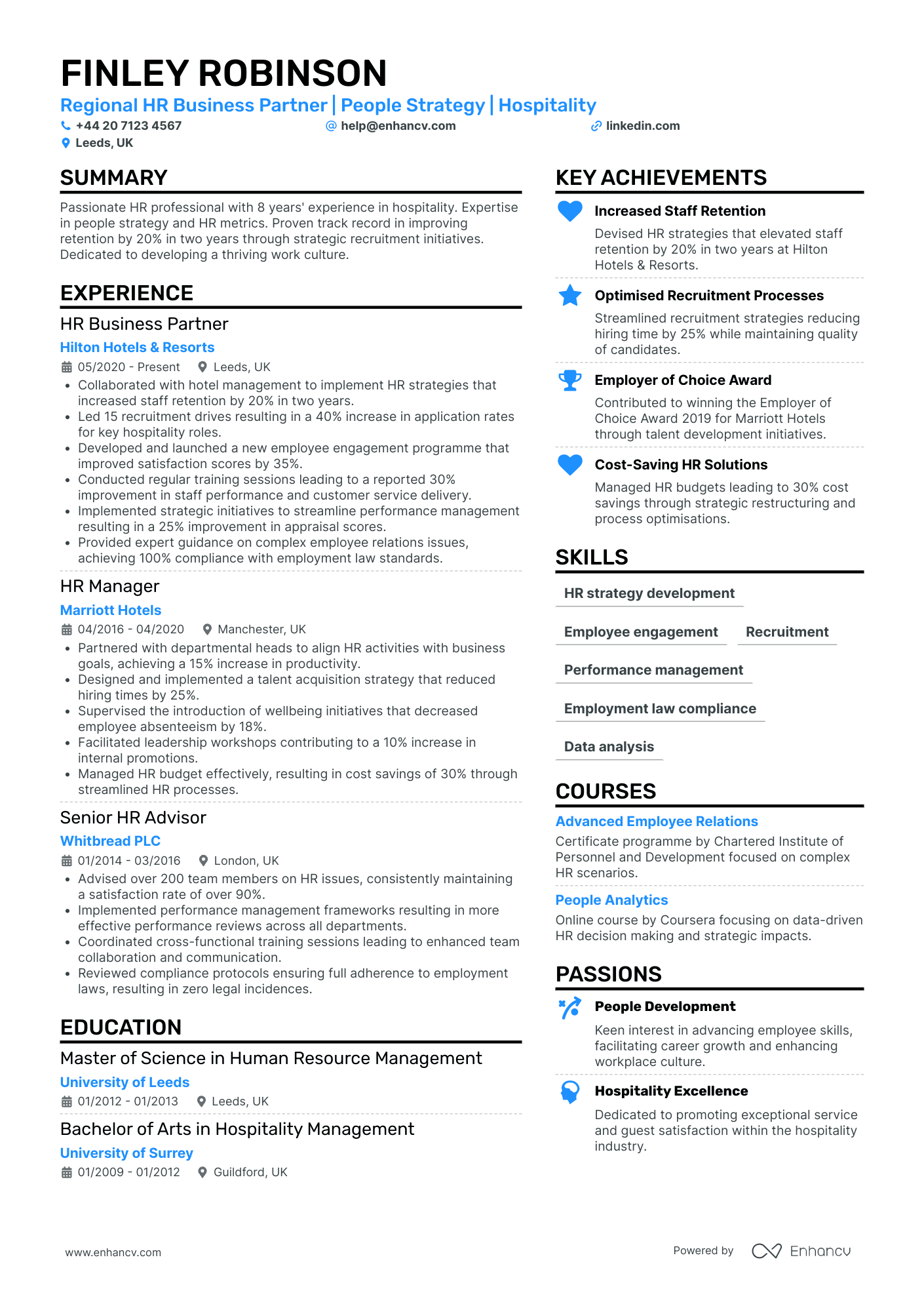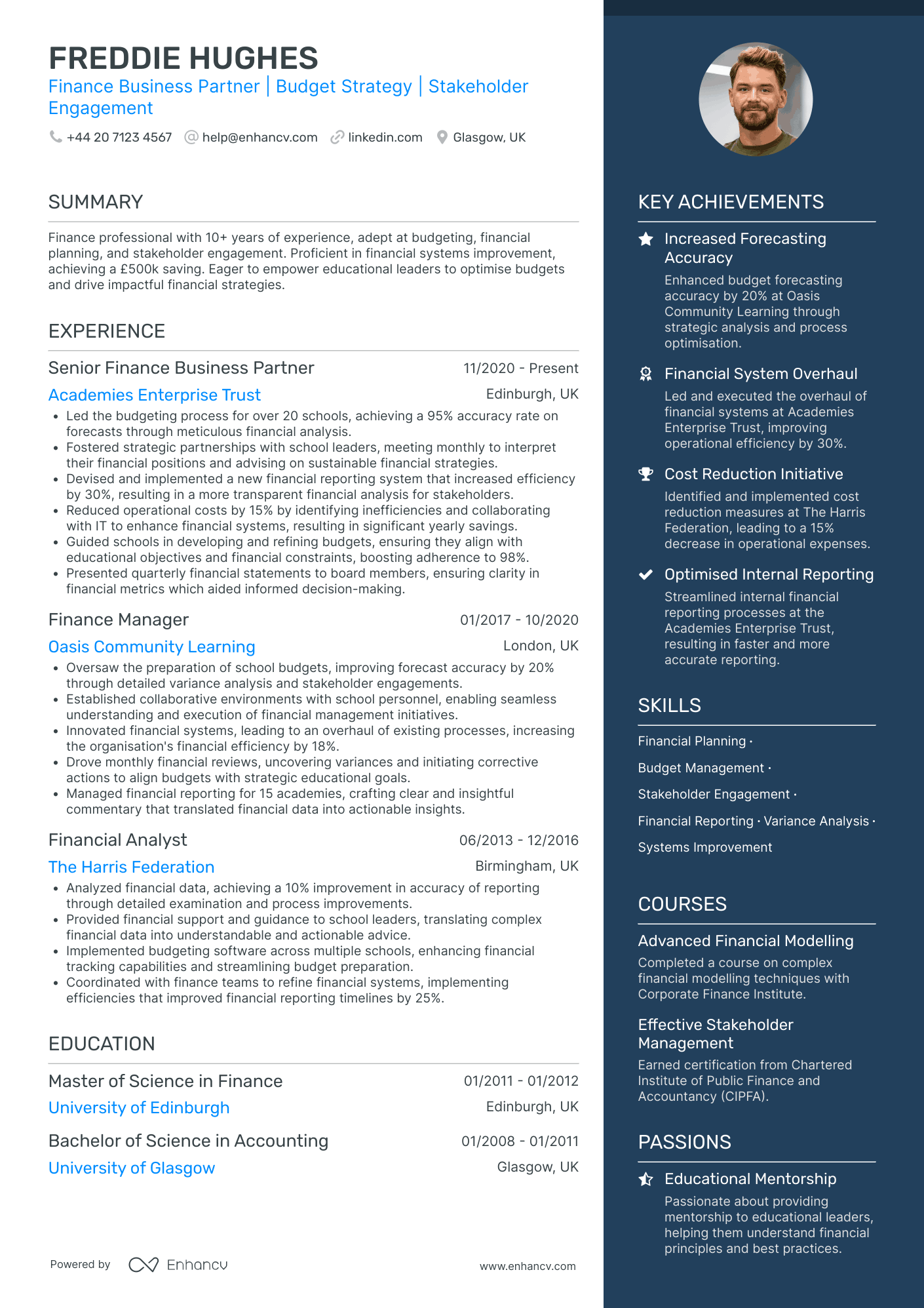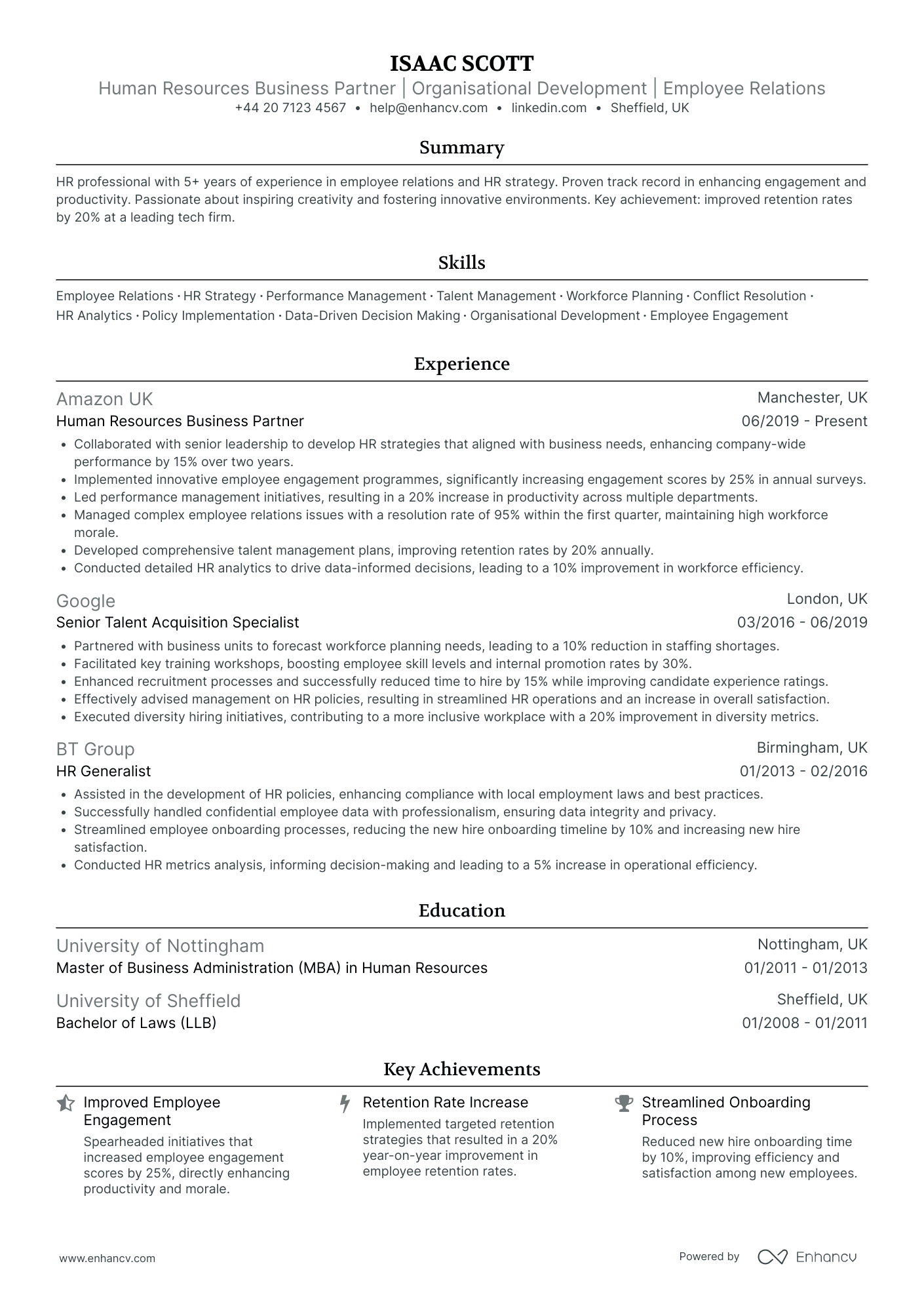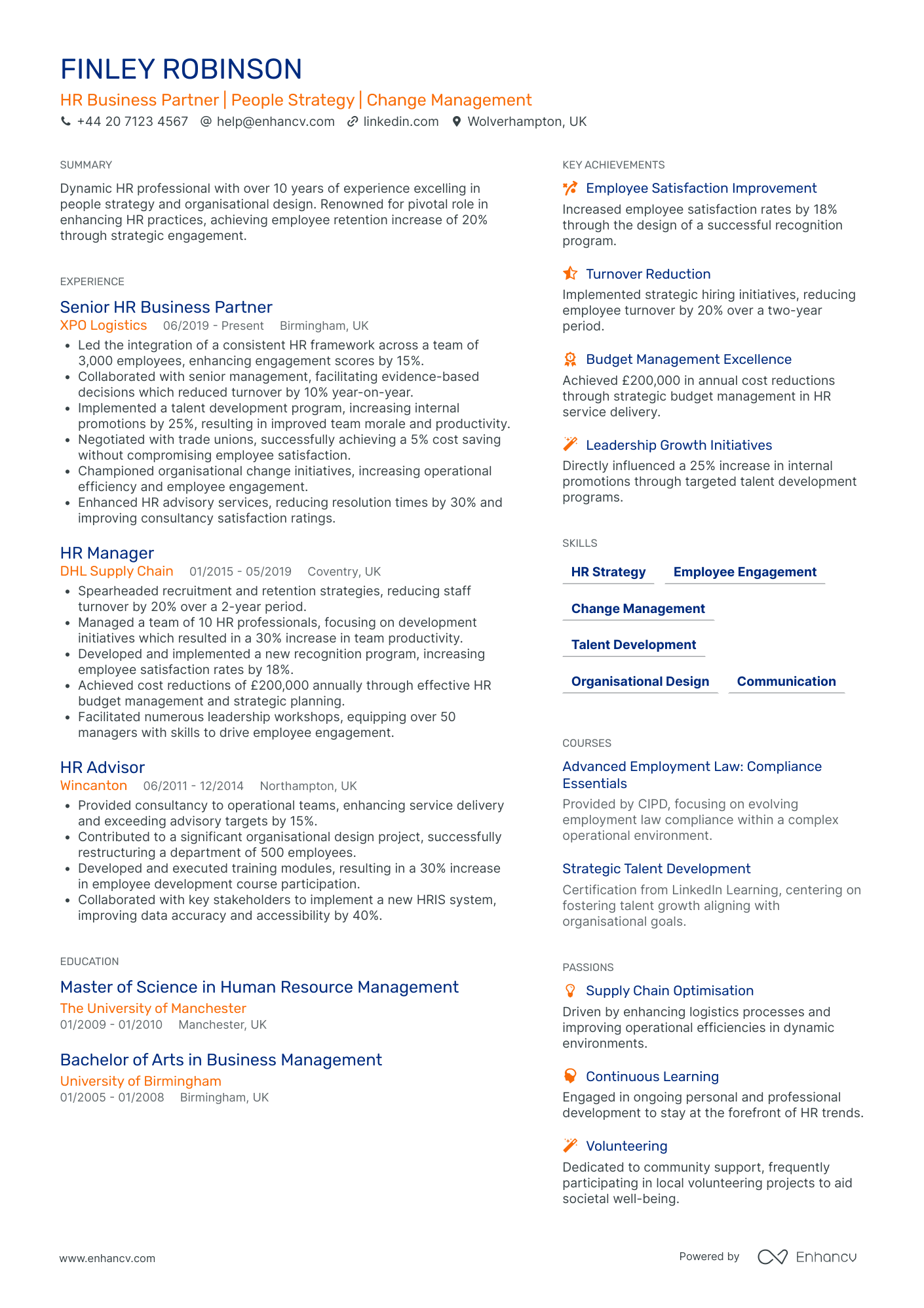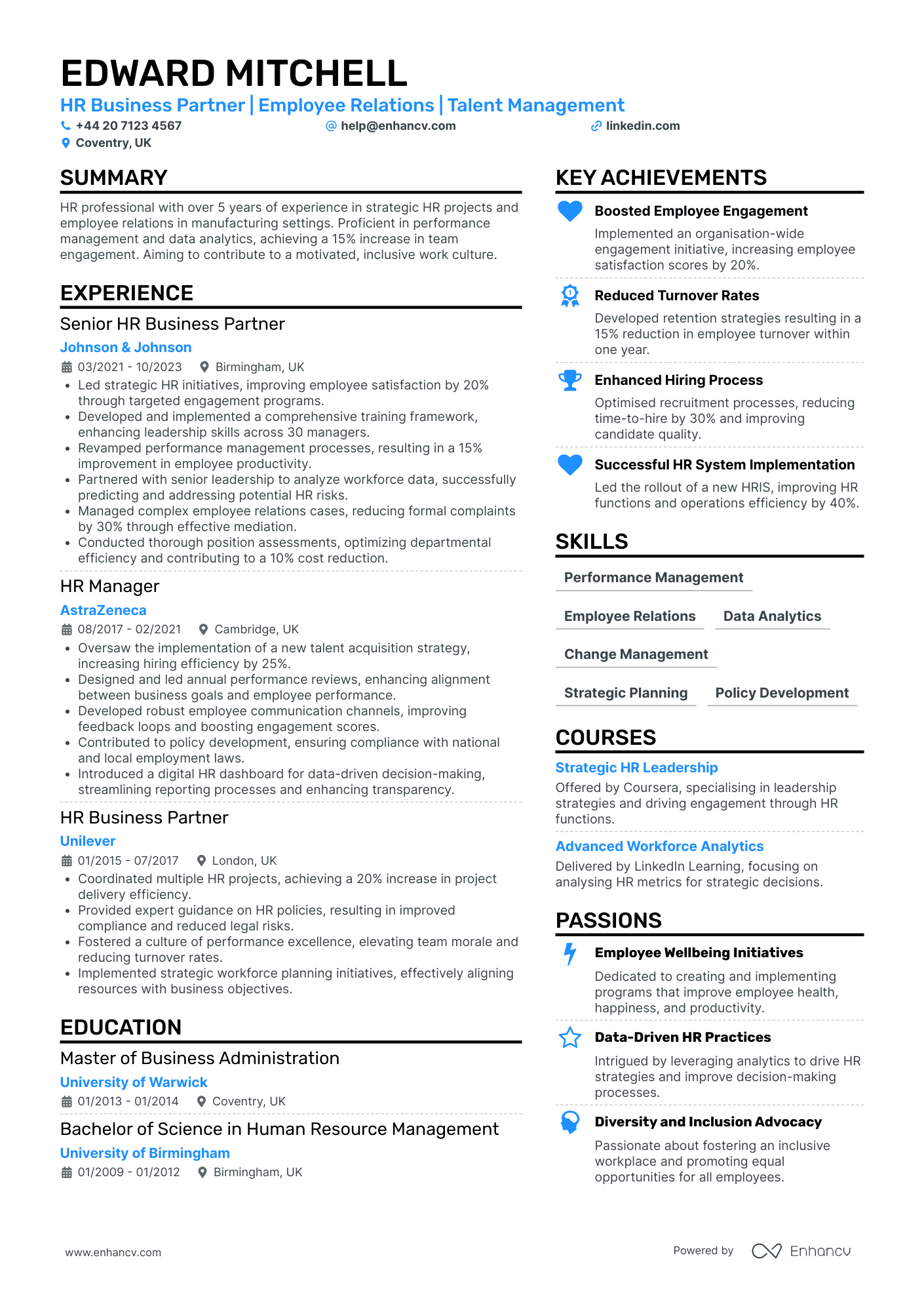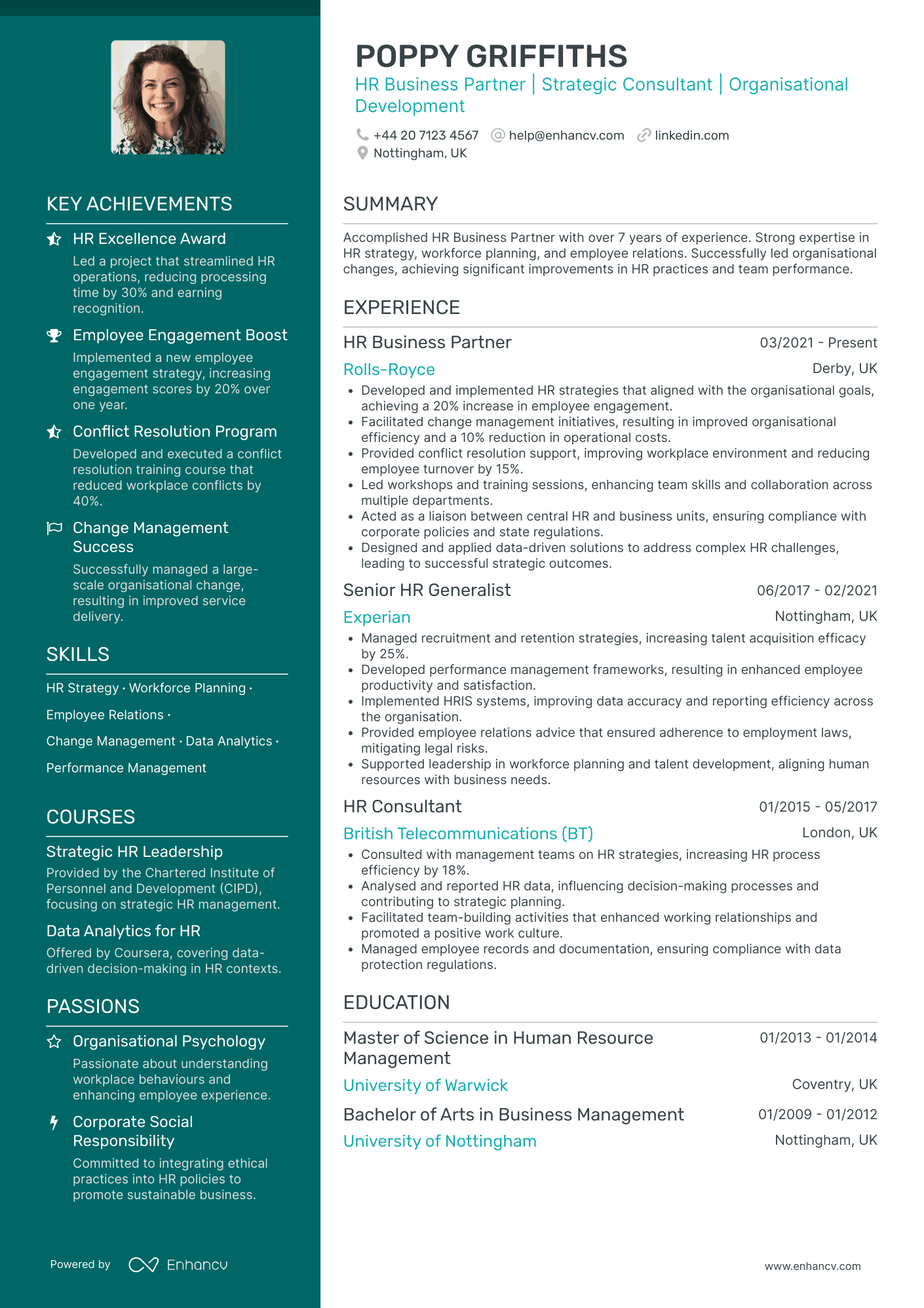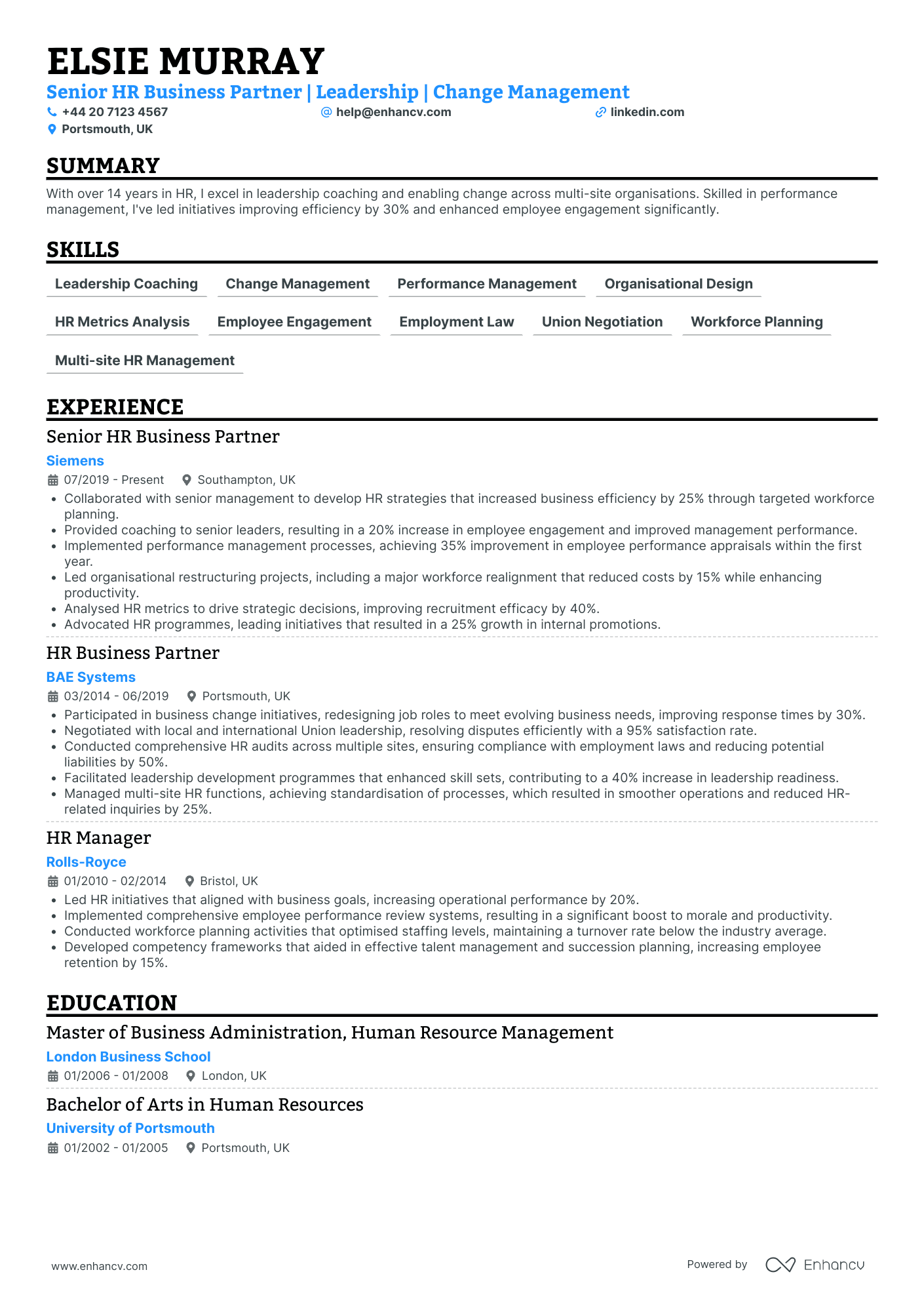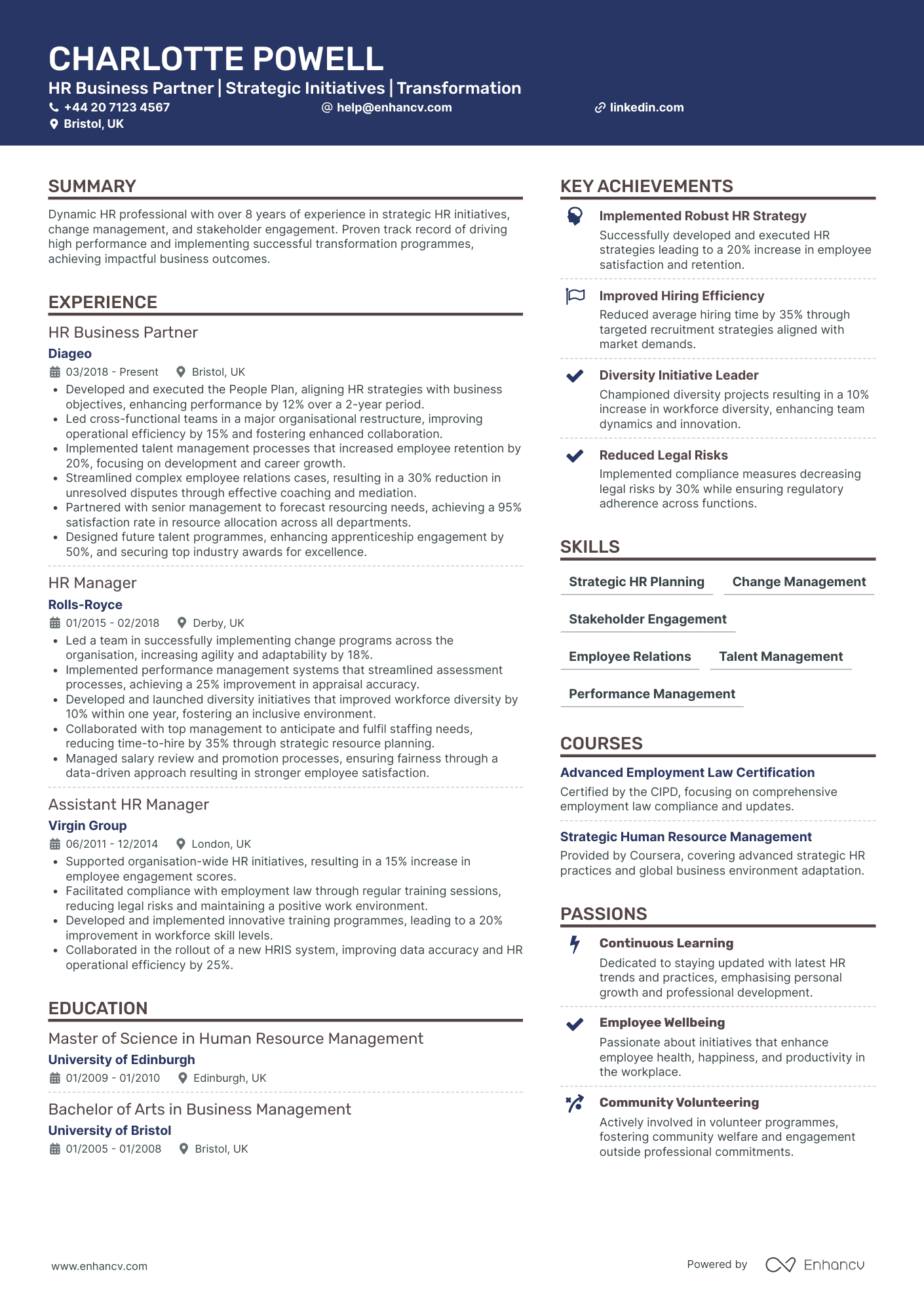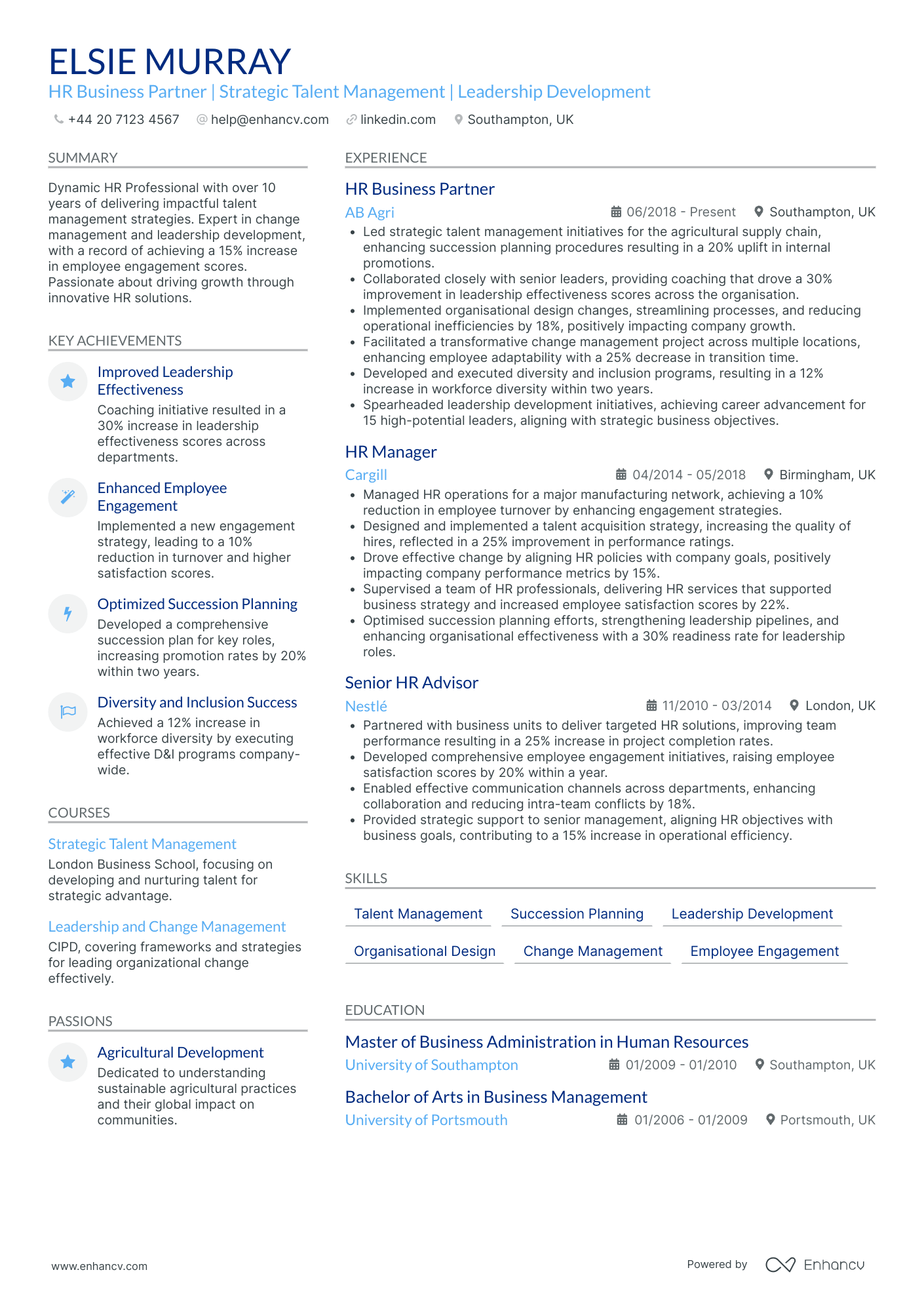Navigating the complexities of tailoring a CV to highlight strategic HR initiatives can be a perplexing challenge for an HR business partner. Our guide provides detailed insights and practical tips to help you craft a CV that showcases your experience in fostering business growth through human capital management.
- Create an attention-grabbing header that integrates keywords and includes all vital information;
- Add strong action verbs and skills in your experience section, and get inspired by real-world professionals;
- List your education and relevant certification to fill in the gaps in your career history;
- Integrate both hard and soft skills all through your CV.
Discover more industry-specific guides to help you apply for any role in the links below:
Resume examples for hr business partner
By Experience
Senior HR Business Partner
- Structured and Focused Content Presentation - The CV stands out due to its organized format, making it easy to read and navigate. The inclusion of clear headers, concise bullet points, and specific dates adds clarity, ensuring that each section is immediately useful to potential employers. The succinct summaries across sections convey key information effectively without overwhelming the reader.
- Demonstrated Career Growth and Sector Experience - Ava’s career trajectory demonstrates consistent growth and advancement through promotions from HR Advisor to Senior HR Business Partner. This progression, accompanied by her experience in well-known retail organizations like J Sainsbury, Tesco, and ASOS, highlights her ability to adapt and excel within fast-paced environments in the retail industry.
- Leadership in Human Resources Practices - Her achievements show a strong capacity for leadership, particularly through her success in employee development and recruitment efficiencies. Initiatives like reducing employee turnover by 15% and boosting internal promotions by 30% indicate not only an understanding of HR fundamentals but also a strategic approach that contributes to organizational growth and morale.
Junior HR Business Partner
- Effective Content Presentation - Freddie Hughes' CV is well-organized, allowing for easy navigation through clear headers and sections. Each section is concise, categorizing information into digestible parts, from contact details to skills and achievements, which makes for a seamless reading experience.
- Impressive Career Trajectory - The progression from an HR Intern at Deloitte to a Senior HR Advisor shows significant career growth. Freddie has advanced from supporting roles to leadership positions, reflecting an upward career movement within the HR industry, highlighting his increasing responsibility and expertise.
- Significant Leadership and Soft Skills - Freddie's ability to lead and influence senior leadership in decision-making and policy alignment shows strong leadership skills. The soft skills detailed, such as stakeholder engagement and conflict resolution, underpin a keen ability to manage and motivate teams, which is crucial for sustaining successful organizational change.
Associate HR Business Partner
- High-impact achievements with clear business relevance - Ella Bennett's CV highlights achievements that go beyond mere statistics to illustrate substantial business impact. For example, her work on payroll accuracy not only achieved a 20% improvement but also helped ensure operational continuity and employee satisfaction, demonstrating her ability to enhance core HR functionality.
- Cross-functional experience and adaptability - This CV showcases Ella's ability to adapt across different levels and functions within organizations. Her transition from a Customer Service Manager to an HR Specialist reflects her versatility and capability to leverage her customer service expertise to improve HR service delivery, fostering a cohesive work environment.
- Soft skills and leadership demonstrated through initiatives - Ella's dedication to fostering employee morale and improving team dynamics is evident in her success in organizing team-building activities and her leadership in a team retention initiative. Her ability to lead and motivate teams underlines her soft skills, enhancing both employee satisfaction and productivity.
Lead HR Business Partner
- Strategic Clarity and Structured Presentation - The CV is meticulously structured, presenting each section logically and systematically. The clarity in showcasing each element of experience, from job positions to specific achievements, allows the reader to easily comprehend and appreciate the candidate's skill set and career progression.
- Continuous Career Growth and Leadership Roles - The career trajectory in the CV highlights a clear path of growth, illustrating movement from an HR Generalist to a Lead HR Business Partner. Each step taken in the candidate's career is marked by increasing seniority and responsibility, reflecting their growing expertise and leadership skills within the HR sector.
- Cross-Functional Impact and HR Innovations - The CV shines in how it demonstrates the candidate’s adaptability and cross-functional experience, particularly in spearheading HR initiatives that lead to holistic organizational improvements. It emphasizes the use of innovative HR tools and methodologies, such as conflict resolution workshops and succession planning frameworks, that directly contribute to operational excellence.
Executive HR Business Partner
- Clarity and structure in content presentation - Mia’s CV is structured to present her career chronology and qualifications clearly. Each section is organized logically, beginning with a strong summary, followed by experience, education, skills, and achievements. The use of bullet points ensures concise delivery of information, making it easy for employers to see how her experience aligns with their needs.
- Adaptability shown through cross-functional experience - Mia has demonstrated her ability to adapt and thrive in various environments, from working at an advertising agency like Ogilvy to a consulting firm such as Deloitte, and finally in a research and data firm like Kantar. This cross-functional expertise underscores her versatility in navigating different industries and managing diverse business objectives effectively.
- Emphasis on measurable achievements and business impact - Mia’s accomplishments are highlighted with quantitative data, like the 25% reduction in operational inefficiencies and a 30% increase in communication alignment. These metrics not only bring credibility to her experience but also communicate her direct impact on business operations and strategic objectives, providing potential employers with a solid understanding of her contributions.
By Role
HR Business Partner in Retail
- Effective content structure and clarity - The CV is neatly organized into sections, making it easy for the reader to locate vital information quickly. Each section is clearly titled, and the bullet points provide concise and relevant insights into each role's responsibilities and achievements.
- Progressive career trajectory - Poppy Griffiths demonstrates clear career advancement within the logistics industry, moving from an HR Advisor to a Senior HR Consultant and subsequently to an HR Business Partner. This growth trajectory highlights her capability to take on increasing responsibilities and lead strategic initiatives effectively.
- Significant achievements with tangible impact - The CV emphasizes several key achievements, such as increasing employee satisfaction scores by 30% and implementing initiatives that resulted in a 15% productivity boost. These accomplishments are not only quantifiable but also speak volumes about her ability to drive impactful change in HR operations.
HR Business Partner in Healthcare
- Comprehensive career progression - The CV traces the candidate's journey from an HR Officer to an HR Business Partner, demonstrating clear career growth through increased responsibilities and leadership roles. The trajectory highlights a deepening of expertise in HR strategy and employee management, showcasing a natural evolution into senior positions.
- Robust achievements with strategic impact - The CV emphasizes achievements that are not just numbers but also outline strategic enhancements in the workplace. Examples include leading TUPE processes that ensured compliance and seamless transitions, and spearheading a strategic HR project to significantly improve employee engagement through mentorship programs, thus demonstrating solid business impact.
- Emphasis on adaptability and cross-functional skills - The overall presentation of experiences and skills highlights the candidate's ability to function cross-functionally within organizations. The CV points to orchestrating compliance processes, designing HR training, and collaborating with recruitment teams to enhance candidate experience, evidencing a flexible approach to HR challenges across various domains.
Strategic HR Business Partner
- Content Presentation and Clarity - The CV is presented with a coherent structure, utilizing bullet points for each experience to clearly outline roles and achievements. This presentation style aids in recognizing significant accomplishments and ensures the content remains concise and easy to navigate, highlighting essential skills and strengths without overwhelming the reader.
- Career Trajectory and Growth - Max Wright's career progression is clearly demonstrated through ascending roles from an HR Advisor to a Strategic HR Business Partner. This upward trajectory showcases a steady growth within the HR sector, underscoring a continuous increase in responsibility and influence within leading companies such as BAT, Unilever, and Diageo.
- Achievements and Business Impact - The CV highlights significant achievements with clear business relevance, such as leading a cultural transformation that increased employee engagement by 25% and improving organizational efficiency by 20%. These accomplishments are not just numerical but also showcase strategic thinking and impactful implementation, reflecting an ability to drive meaningful change.
HR Business Partner in Technology
- Clear and Structured Presentation - The CV is expertly crafted with distinct sections that offer clarity and brevity. Each part, from experience to education, is presented in a logically structured manner, making it easy to navigate and absorb key details. This clarity underscores Daniel's ability to communicate effectively, a vital skill in HR roles.
- Distinct Career Progression in HR - Daniel's career trajectory showcases a steady rise through key HR positions, starting from a Talent Development Specialist to an HR Business Partner. This growth reflects his increasing expertise and leadership abilities within the HR field, illustrating a commitment to advancing professional capabilities and responsibility in renowned companies.
- Effective Use of Industry-Specific Achievements - The CV includes impactful industry-specific achievements that not only highlight skills but also their business relevance. Metrics, such as a 30% improvement in team performance and zero critical role vacancies, demonstrate the tangible impact of his HR strategies and leadership on organizational success, showcasing his ability to drive significant business outcomes.
HR Business Partner in Manufacturing
- Strategic impact through measurable achievements - Mia Ward's CV impresses with a collection of accomplishments that are both quantifiable and relevant to the business objectives. The reduction of the hiring timeline by 30% at GKN Aerospace stands out as a key contribution, alongside productivity and retention enhancements, demonstrating her ability to drive significant changes within complex manufacturing environments.
- Diverse skill set with industry-specific expertise - The CV highlights Mia's proficiency in HR tools and management methodologies tailored to the aerospace and manufacturing sectors. Her ability to manage HR projects integrating advanced technologies further showcases her technical depth and innovation-driven approach, essential in evolving industries.
- Clear career progression with increasing responsibility - Mia's career trajectory is marked by a steady progression from an HR Officer role at BAE Systems to an HR Business Partner position at GKN Aerospace. Each role showcases growth, reflecting enhanced responsibilities and greater influence in strategic HR processes across leading companies. This trajectory underscores her expanding impact within the sector.
HR Business Partner in Education
- Clarity and Structure - The CV is well-organized with clearly defined sections such as experience, education, and skills. Each section is concise and informative, making it easy for employers to quickly assess the candidate's qualifications and career progression. Job responsibilities and achievements are presented in bullet points, enhancing readability and focus.
- Career Trajectory and Growth - Leo Brown's career progression is logical and demonstrates growth, advancing from HR Coordinator to HR Officer. Each role indicates accumulating responsibilities and expertise, maintaining a consistent focus on HR in educational institutions, highlighting a deep commitment to the field.
- Achievements and Business Impact - The CV highlights significant achievements that have directly impacted the institutions Leo worked for, such as improving employee satisfaction by 30% and reducing turnover by 20%. These points underscore not just personal success but also the ability to drive organizational improvement and align HR strategies with business goals.
Regional HR Business Partner
- Clear Structure and Conciseness in Presentation - The CV is well-organized, beginning with a succinct header that immediately identifies the candidate's name, current role, and contact details. Each section, from experience to education, is clearly delineated, making it easy for the reader to navigate and extract essential information quickly. Details are concise and focused on the candidate's key achievements and skills relevant to HR in hospitality.
- Strategic Career Growth in Hospitality HR - Finley Robinson's career trajectory highlights a clear path of upward mobility across esteemed hospitality brands such as Hilton Hotels, Marriott Hotels, and Whitbread PLC. This progression demonstrates his ability to leverage his expertise and adapt to increasingly responsible roles, reflecting mature mastery of HR functions specifically within the hospitality sector, which requires nuanced skills in people management and service excellence.
- Emphasis on Achieving Business-Relevant Outcomes - The CV stands out with achievements that don't just provide statistics but highlight their business implications. For example, the improvement in staff retention, recruitment efficiency, and engagement programs are directly tied to enhanced productivity and customer satisfaction—key metrics in the hospitality industry. These results driven by strategic HR initiatives underscore Robinson's knack for delivering real, quantifiable business value.
HR Business Partner in Finance
- Strategically Structured Content - The CV is impressively structured, presenting information in a logical and concise manner. The use of clear headings and bullet points enhances readability, making it easy to navigate through Freddie Hughes' professional background. The emphasis on measurable outcomes and defined timelines adds clarity to his career narrative.
- Progressive Career Advancement - Freddie Hughes' career trajectory showcases significant growth with progressive roles in financial management across educational institutions. Starting as a Financial Analyst and advancing to a Senior Finance Business Partner position illustrates his continuous development and ability to take on greater responsibilities in strategic financial planning.
- Distinctive Expertise in Educational Finance - The CV highlights industry-specific skills such as budget management and stakeholder engagement, particularly tailored to the educational sector. Freddie's initiatives in financial systems improvement and educational mentorship reflect a deep understanding of how to align financial strategies with educational objectives, showcasing his unique contributions to the sector.
Global HR Business Partner
- Strategically Structured Presentation - The CV is organized into distinct sections, allowing for clear navigation through Isaac Scott’s professional journey. The presentation highlights key competencies and achievements in a concise manner, facilitating easy comprehension for any reader.
- Progressive Career Path - Isaac Scott’s career trajectory highlights impressive growth from an HR Generalist at BT Group to a Senior Talent Acquisition Specialist at Google and upwards to a Human Resources Business Partner at Amazon UK. This upward momentum showcases his ability to seek greater responsibilities and drive change across prominent tech companies.
- Implementation of Innovative HR Solutions - The CV illustrates the candidate’s unique application of HR analytics and strategic initiatives that dramatically enhance employee engagement, retention, and workforce efficiency. His capacity to integrate data-driven decision making with advanced employee engagement strategies underscores his technical depth and innovation in HR practices.
HR Business Partner in Logistics
- Well-Structured Presentation - This CV excels in organization and clarity, offering a clearly structured presentation with distinct sections for experience, education, skills, and achievements. It quickly guides the reader through the candidate's professional journey with concise bullet points that highlight key accomplishments and skills.
- Progressive Career Trajectory - Finley Robinson's career shows a clear upward trajectory with progressive roles from HR Advisor to Senior HR Business Partner. The CV captures significant promotions and expanded responsibilities over time, reflecting growth in expertise and contributions to leading logistics companies.
- Emphasis on Strategic HR Initiatives - The CV includes industry-specific elements such as the implementation of talent development programs, strategic HR frameworks, and trade union negotiations. These aspects demonstrate Finley's technical depth in HR and their ability to influence change at an organizational level, particularly in enhancing employee engagement and retention.
HR Business Partner in Hospitality
- Clear Presentation and Structured Organization - Edward Mitchell's CV is well-organized and structured, clearly separating sections such as professional experience, education, and skills. This clarity allows potential employers to quickly assess his qualifications and determine his suitability for the role.
- Career Growth and Industry Relevance - The CV highlights significant career growth from an HR Business Partner at Unilever to a Senior HR Business Partner at Johnson & Johnson. This progression indicates a strong capability to handle increasing responsibility in prominent multinational corporations, which is pivotal for someone in HR leadership.
- Achievements with Tangible Business Impact - The CV effectively articulates achievements with quantifiable results, such as improving employee satisfaction by 20% and reducing turnover rates by 15%. This not only emphasizes Edward's effectiveness as an HR professional but also demonstrates his direct impact on organizational health and productivity.
HR Business Partner in Non-Profit
- Clear and Structured Presentation - The CV is well-organized, making it easy to navigate through the candidate's qualifications. The sections are concisely titled, and the use of bullet points for responsibilities and achievements enhances readability. This clarity ensures that important career milestones and skills aren't overlooked by potential employers.
- Diverse Career Progression - Poppy Griffiths' career trajectory is marked by significant growth and responsibilities, transitioning from an HR Consultant to a Senior HR Generalist and further to an HR Business Partner. This progression not only demonstrates her ability to adapt to increased levels of responsibility but also highlights a strong commitment to professional development within the HR field.
- Impactful Achievements with Business Relevance - The CV highlights achievements that are not just about numbers but demonstrate a broader impact on the business. For example, the 20% increase in employee engagement and 10% reduction in operational costs at Rolls-Royce reflect significant contributions to organizational health and efficiency, underscoring her strategic influence within the HR domain.
HR Business Partner in Energy
- Comprehensive Display of Career Progression - Elsie Murray's CV effectively traces a clear career trajectory, showcasing her steady progression from an HR Manager to a Senior HR Business Partner. This emphasizes her growth in responsibility and expertise within the HR domain across major organizations like Siemens, BAE Systems, and Rolls-Royce.
- Strategic and Operational Impact - The CV highlights significant achievements, such as improving business efficiency by 25% and reducing costs by 15%, demonstrating her strategic influence and operational impact. These accomplishments not only quantify her contributions but also underline her adeptness in aligning HR strategies with organizational goals.
- Diverse Skill Set and Industry-Specific Certifications - Elsie showcases a robust set of skills including Leadership Coaching, Change Management, and HR Metrics Analysis. Additionally, she complements these with industry-relevant courses like Strategic Workforce Planning Certification, which enriches her profile with targeted HR strategic planning capabilities.
HR Business Partner in Construction
- Structured and Concise Presentation - The CV uses a well-organized format that enables easy navigation through structured sections like experience, education, and achievements. Bullet points help distill complex information into clear, concise highlights, aiding quick comprehension and emphasizing key facts.
- Strategic Career Progression - Charlotte's career trajectory is impressive, reflecting steady advancement from Assistant HR Manager to HR Business Partner. Each step indicates increasing responsibility and scope—moving from HR support functions to strategic leadership roles in renowned companies, showcasing professional growth and capability to manage larger-scale HR transformations.
- Cross-Functional Leadership Skills - The CV highlights Charlotte’s ability to lead cross-functional initiatives effectively. This is reflected in their accomplishments in organizational restructure and talent management, involving key stakeholders across departments. Such skills are critical in fostering collaboration and integrating HR strategies with overall business objectives.
HR Business Partner in Agriculture
- Effective Content Presentation - Elsie Murray's CV is structured with clarity and conciseness, allowing the reader to easily navigate through her professional journey. The use of bullet points under each role facilitates quick absorption of key responsibilities and achievements, exemplifying a commitment to clear communication that an HR professional highly values.
- Progressive Career Trajectory - The CV illustrates a commendable growth path from a Senior HR Advisor to an HR Business Partner. This upward mobility reflects her ability to steadily take on more responsibilities and challenges, indicating her dedication and competence in the HR field across notable companies like Nestlé and AB Agri.
- Comprehensive Achievement Impact - Elsie's achievements highlight her success in driving significant business outcomes, such as improving employee engagement scores and leadership effectiveness. Beyond the impressive metrics, these accomplishments translate into enhanced organizational performance and align well with strategic business objectives, showcasing her strategic impact on the businesses she has worked with.
How to ensure your profile stands out with your hr business partner CV format
It's sort of a Catch 22. You want your hr business partner CV to stand out amongst a pile of candidate profiles, yet you don't want it to be too over the top that it's unreadable. Where is the perfect balance between your CV format simple, while using it to shift the focus to what matters most. That is - your expertise. When creating your hr business partner CV:
- list your experience in the reverse chronological order - starting with your latest roles;
- include a header with your professional contact information and - optionally - your photograph;
- organise vital and relevant CV sections - e.g. your experience, skills, summary/ objective, education - closer to the top;
- use no more than two pages to illustrate your professional expertise;
- format your information using plenty of white space and standard (2.54 cm) margins, with colours to accent key information.
Once you've completed your information, export your hr business partner CV in PDF, as this format is more likely to stay intact when read by the Applicant Tracker System or the ATS. A few words of advice about the ATS - or the software used to assess your profile:
- Generic fonts, e.g. Arial and Times New Roman, are ATS-compliant, yet many candidates stick with these safe choices. Ensure your CV stands out by using a more modern, and simple, fonts like Lato, Exo 2, Volkhov;
- All serif and sans-serif fonts are ATS-friendly. Avoid the likes of fancy decorative or script typography, as this may render your information to be illegible;
- Both single- and double-column formatted CVs could be assessed by the ATS;
- Integrating simple infographics, icons, and charts across your CV won't hurt your chances during the ATS assessment.
PRO TIP
Use bold or italics sparingly to draw attention to key points, such as job titles, company names, or significant achievements. Overusing these formatting options can dilute their impact.
The top sections on a hr business partner CV
- Professional Summary highlights your HR expertise and value.
- Key HR Competencies section showcases your specific HR skills.
- Work Experience details your relevant HR roles and achievements.
- Education and Certifications underscore your formal HR training.
- HR Projects and Initiatives demonstrate your hands-on experience.
What recruiters value on your CV:
- Highlight your understanding of HR strategic alignment by detailing your experience in linking HR initiatives with business goals and the impact it had on organisational performance.
- Illustrate your interpersonal and communication skills by providing examples of successful stakeholder management, conflict resolution, and negotiation that you orchestrated within a complex organisational structure.
- Emphasise your analytical capabilities by mentioning specific HR metrics or performance indicators you have used to inform business decisions and improve HR processes.
- Showcase your employee engagement strategies by discussing programmes you've implemented to increase retention, enhance company culture, or improve employee satisfaction.
- Demonstrate your knowledge of employment law and regulatory compliance by detailing any experience in policy development and the proactive management of legal risks.
Recommended reads:
What information should you include in your hr business partner CV header?
The CV header is potentially the section that recruiters would refer to the most, as it should include your:
- Contact details - your professional (non-work) email address and phone number;
- Professional photograph - if you're applying hinting at the value you bring as a professional.
Many professionals often struggle with writing their hr business partner CV headline. That's why in the next section of this guide, we've curated examples of how you can optimise this space to pass any form of assessment.
Examples of good CV headlines for hr business partner:
- Strategic HR Business Partner | Employee Engagement Specialist | CIPD Certified | 7 Years’ Experience
- Senior HR Business Partner | Talent Acquisition & Development Guru | MBA in HRM | 10+ Years’ Expertise
- Associate HR Business Partner | Diversity & Inclusion Advocate | HR Analytics | 3 Years in HR
- Lead HR Business Partner | Change Management Lead | Organisational Design | 15 Years’ HR Leadership
- HR Business Partner | Performance Management Expert | Employee Relations | SHRM-SCP | 5+ Years’ Practice
- Global HR Business Partner | Cross-Cultural Team Integration | Succession Planning | 12 Years Strategic HR Initiatives
Catching recruiters' attention with your hr business partner CV summary or objective
Located closer to the top of your CV, both the summary and objective are no more than five sentences long and serve as an introduction to your experience. What is more, you could use either to entice recruiters to read on. Select the:
- Summary, if you happen to have plenty of relevant experience. Feature your most impressive accomplishments and up to three skills that are relevant to the job you're applying for;
- Objective, if you're just starting your career off. Provide your career goals and answer how you see the role you are applying for will match your professional growth.
Judging which one you need to add to your hr business partner CV may at times seem difficult. That’s why you need to check out how professionals, with similar to your experience, have written their summary or objective, in the examples below:
CV summaries for a hr business partner job:
How to meet job requirements with your hr business partner CV experience
We've now reached the essence of your actual CV - your experience section. This is the space where you can list your career roles and on-the-job successes. Many candidates tend to underestimate just how much time and effort they should put into writing this CV section. Your experience shouldn't be a random list of your responsibilities, but instead:
- Match the job description with your skills, values, and accomplishments;
- Start each bullet with a strong action verb, followed up with one key skill and your outcome of applying this skill;
- Spotlight parts of your career history that are relevant to the job you're applying for.
Before we move on, make sure to check out some professional CV experience sections.
Best practices for your CV's work experience section
- Strategically partnered with departmental managers to align HR initiatives with business goals, achieving a 15% increase in employee retention over two years.
- Developed and implemented a comprehensive talent management programme that reduced time-to-hire by 25% and significantly improved recruitment quality.
- Led a successful company-wide restructuring process resulting in a more streamlined organisation, while maintaining employee engagement and morale.
- Facilitated the development and rollout of a bespoke leadership training curriculum, enhancing the capabilities of middle and senior management teams.
- Implemented a diversity and inclusion strategy that improved minority representation in key positions by 20% within eighteen months.
- Conducted thorough HR audits to ensure compliance with employment laws and regulations, mitigating risk and reinforcing ethical standards throughout the organisation.
- Collaborated with the HR technology team to introduce an advanced HRIS system, enhancing data accuracy and enabling more strategic HR decision-making.
- Influenced organisational culture by introducing progressive HR policies that increased job satisfaction scores by 30% in employee surveys.
- Played a pivotal role in managing complex employee relations issues, maintaining a 98% success rate in resolving conflicts without legal escalations.
- Spearheaded a strategic HR initiative aimed at revamping the recruitment process, reducing time-to-hire by 30% and enhancing the quality of candidates.
- Led the development and implementation of a comprehensive employee engagement programme that uplifted overall employee satisfaction scores by 25%.
- Collaborated closely with senior management to align HR strategies with business goals, resulting in a marked improvement in workforce productivity by 15%.
- Designed and executed the talent development framework, boosting leadership pipeline strength and promoting 20+ employees to management roles.
- Reduced staff turnover by 18% through the introduction of bespoke career progression planning and mentoring systems.
- Orchestrated the successful negotiation and management of workforce relations, mitigating legal risks and fostering a culture of transparency and respect.
- Implemented an analytics-driven performance management system, allowing for personalized KPIs and increasing team efficiency by 22%.
- Directed the change management efforts for a major corporate restructuring, ensuring seamless transition and preserving employee morale.
- Championed the company's diversity and inclusion initiative, enhancing the representation of minority groups within the firm by 15%.
- Led a company-wide HR digital transformation project, integrating cloud-based HRIS resulting in improved data accuracy and reporting capabilities.
- Piloted a new performance-based compensation programme, aligning employee incentives with company performance metrics and boosting sales by 10%.
- Facilitated an inter-departmental skills-sharing initiative that enhanced cross-functional collaboration and knowledge transfer.
- Devised and executed a hiring strategy targeting high-potential graduates, increasing the talent pool by 40% and successfully filling key technological positions.
- Pioneered a data-driven retention strategy that decreased high-potential employee turnover by 12% within the first year of implementation.
- Masterminded a leadership development programme, culminating in a 20% increase in internally promoted leaders.
- Coordinated the international mobility programme, enhancing global talent deployment while ensuring compliance with different countries' employment laws.
- Established a wellness programme that cut down healthcare costs by 10% and reduced absenteeism due to health reasons by 8%.
- Managed the successful integration of HR practices following a merger, harmonizing systems and policies across the newly formed entity.
- Introduced a robust HR metrics and analytics dashboard, enabling data-driven decisions and optimizing human capital investment.
- Played a pivotal role in the development of a comprehensive competency framework to foster a culture of continuous learning and development.
- Instrumental in restructuring the sales division, which led to a 5% increase in sales productivity and a reduction in operational redundancies.
- Constructed and implemented an employee value proposition that enhanced the employer brand and influenced a 20% growth in top-tier candidate applications.
- Orchestrated an employee feedback programme that identified key areas for improvement, leading to a tailored training plan and a 13% increase in staff competencies.
- Facilitated the reorganisation of the IT department to better align with emerging technology trends, resulting in a 17% increase in project delivery efficiency.
Lacking professional expertise: how to write your CV to highlight your best talents
Don't count on your lucky stars when you're applying for a role, where you happen to have less (or almost none) professional experience. Recruiters sometimes do hire inexperienced candidates if they're able to present their unique value from the get-go. So, instead of opting for the traditional, CV experience section:
- List any applicable expertise you happen to have - no matter if it's a part-time job, internship, or volunteer work. This would hint to recruiters that your profile is relevant;
- Focus your CV on your transferrable skills or talents you've obtained thanks to your whole life and work experience. In effect, you'll be spotlighting your value as a candidate;
- Separate more space for your applicable academic background and certificates to show you have the technical know-how;
- Ensure that within your objective, you've defined why you'll like the job and how you'll be the perfect match for it. Always ensure you've tailored your CV to individual applications.
Looking for more good examples for your first job? We'll show you how other candidates, with less professional experience, have created their job-winning CVs.
Recommended reads:
PRO TIP
Describe how each job helped you grow or learn something new, showing a continuous development path in your career.
Describing your unique skill set using both hard skills and soft skills
Your hr business partner CV provides you with the perfect opportunity to spotlight your talents, and at the same time - to pass any form of assessment. Focusing on your skill set across different CV sections is the way to go, as this would provide you with an opportunity to quantify your achievements and successes. There's one common, very simple mistake, which candidates tend to make at this stage. Short on time, they tend to hurry and mess up the spelling of some of the key technologies, skills, and keywords. Copy and paste the particular skill directly from the job requirement to your CV to pass the Applicant Tracker System (ATS) assessment. Now, your CV skills are divided into:
- Technical or hard skills, describing your comfort level with technologies (software and hardware). List your aptitude by curating your certifications, on the work success in the experience section, and technical projects. Use the dedicated skills section to provide recruiters with up to twelve technologies, that match the job requirements, and you're capable of using.
- People or soft skills provide you with an excellent background to communicate, work within a team, solve problems. Don't just copy-paste that you're a "leader" or excel at "analysis". Instead, provide tangible metrics that define your success inusing the particular skill within the strengths, achievements, summary/ objective sections.
Top skills for your hr business partner CV:
Human Resources Management
Recruitment & Staffing
Employee Relations
Performance Management
HR Policies & Procedures
Talent Development
Compensation & Benefits
HR Analytics
Employment Law Compliance
Change Management
Communication
Interpersonal Skills
Problem Solving
Negotiation
Critical Thinking
Leadership
Teamwork
Empathy
Organisational
Adaptability
PRO TIP
If you have received professional endorsements or recommendations for certain skills, especially on platforms like LinkedIn, mention these to add credibility.
Further professional qualifications for your hr business partner CV: education and certificates
As you're nearing the end of your hr business partner CV, you may wonder what else will be relevant to the role. Recruiters are keen on understanding your academic background, as it teaches you an array of hard and soft skills. Create a dedicated education section that lists your:
- applicable higher education diplomas or ones that are at a postgraduate level;
- diploma, followed up with your higher education institution and start-graduation dates;
- extracurricular activities and honours, only if you deem that recruiters will find them impressive.
Follow a similar logic when presenting your certificates. Always select ones that will support your niche expertise and hint at what it's like to work with you. Balance both technical certification with soft skills courses to answer job requirements and company values. Wondering what the most sought out certificates are for the industry? Look no further:
PRO TIP
Use mini case studies or success stories in your CV to demonstrate how your skills have positively impacted previous roles or projects.
Recommended reads:
Key takeaways
Here are five things you need to remember about writing your hr business partner CV for success:
- Sort your experience based on the reverse chronological order, starting with your most recent career items, to showcase how you've grown your career;
- Include within your CV header your relevant contact details, a headline that could spotlight your unique value, and a photo - if you're applying for roles outside the UK or US;
- Decide to use the CV summary, if you happen to have more professional experience, and an objective, if you want to showcase your career goals;
- Within the experience section, write your bullets using action verbs, skills, and success, instead of just merely listing your on-the-job responsibilities;
- Prove your technical skills, using your education and certificates, and your soft skills, with your achievements and strengths sections.
